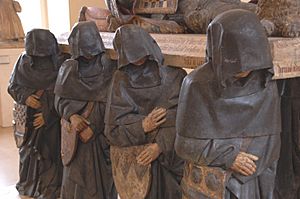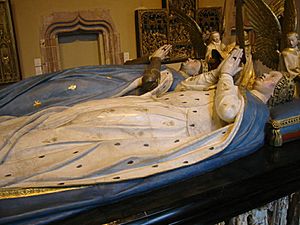Antoine Le Moiturier facts for kids


Antoine Le Moiturier (born 1425, died 1495) was an important French sculptor. He was born in Avignon, a city in France, into a family where many people were sculptors. His uncle, Jacques Morel, was also a famous artist who traveled a lot for his work. Antoine Le Moiturier is best known for his detailed sculptures, especially those found on tombs.
Who Was Antoine Le Moiturier?
Antoine Le Moiturier lived during the 15th century, a time when art was changing a lot. He learned his skills from his family and became a master sculptor himself. His work often showed strong feelings and detailed clothing, which was common in art during that period.
The Famous Mourners of Dijon
One of Le Moiturier's most famous works is a group of sculptures called the Mourners of Dijon. These sculptures are also known as "Pleurants," which is a French word meaning "weepers" or "mourners." They are figures shown crying or grieving.
- These sculptures are part of the tombs of Duke John the Fearless and Margaret of Bavaria.
- They are located in the Palace of the Dukes of Burgundy in Dijon, France.
- The work on these tombs started in 1443 by another artist, Jean de la Huerta.
- Antoine Le Moiturier finished the sculptures in 1470.
- The job was originally planned for the workshop of Claus Sluter, but Le Moiturier and De la Huerta took over.
Other Important Works
Antoine Le Moiturier also created other significant artworks during his career.
- In 1461, he was asked to create an altarpiece for a church called St Pierre in Avignon. An altarpiece is a piece of art, often a painting or sculpture, placed behind the altar in a church.
- The person who hired him, Canon Jacques Oboli, passed away before the work was done.
- In 1463, the church officially asked Le Moiturier to create an altarpiece showing the Last Judgment.
- He finished this large project two years later.
- The altarpiece included statues of important figures like Jesus, Saint Peter, Saint Paul, and many angels.
- Sadly, out of more than sixteen original sculptures, only two remain today.
Le Moiturier is also thought to have created the "pleurants" (mourning figures) on the tomb of Philippe Pot. This tomb was made between 1477 and 1483.
See also
 In Spanish: Antoine Le Moiturier para niños
In Spanish: Antoine Le Moiturier para niños

